Do you have a question about the Carrier Infinity 25HNB5 and is the answer not in the manual?
Warning about the danger of electrical shock during installation and servicing.
Warning about the risk of explosion from using oxygen or air for leak testing.
Key guidelines for unit placement, refrigerant line routing, and vibration absorption.
Procedures for unpacking, inspecting for damage, and verifying unit specifications.
Specifies ambient temperature ranges and unit elevation guidelines.
Critical safety warnings regarding refrigerant handling, burial, and valve protection.
Procedure for installing the adapter tube onto the liquid service valve.
Guidelines for brazing connections, including fire safety precautions.
Process for evacuating refrigerant tubing and coil using the deep vacuum method.
Instructions for connecting unit ground, power, and 24V control wiring.
Importance of wiring checks, crankcase heater, and accessory installation.
How to check the installation of Outdoor Air and Coil Temperature thermistors.
Critical safety precautions for unit startup to prevent damage or injury.
Guidance on using the subcooling method to check and adjust refrigerant charge.
How to use the heating check chart to verify system operation.
Describes sequences for cooling and heating with standard thermostats.
Explains operation for both cooling and heating demands in heat pump systems.
Explains the function of COMM and Amber status LEDs.
Details on crankcase heater and outdoor fan motor operation.
Lists the various time delays implemented in the unit's operation.
How utility interface functions with Infinity and standard controls.
Conditions and configurations for low ambient cooling operation.
Explains defrost hold, forced defrost initiation, and Quiet Shift-2.
Wiring instructions for liquid line solenoids with different controls.
Overview of control board functions and compressor internal protection.
Troubleshooting communication failures, brown outs, and voltage problems.
Diagnosing issues related to pressure switches and compressor thermal cutouts.
How thermistors are compared and default operations upon failure.
Interpreting status codes flashed by the amber LED for diagnostics.
Final checks on wiring, tubing security, valve caps, and user manual handover.
Recommendations for ongoing periodic maintenance of the equipment.
Key information and precautions for servicing Puron refrigerant systems.
Warning about the danger of electrical shock during installation and servicing.
Warning about the risk of explosion from using oxygen or air for leak testing.
Key guidelines for unit placement, refrigerant line routing, and vibration absorption.
Procedures for unpacking, inspecting for damage, and verifying unit specifications.
Specifies ambient temperature ranges and unit elevation guidelines.
Critical safety warnings regarding refrigerant handling, burial, and valve protection.
Procedure for installing the adapter tube onto the liquid service valve.
Guidelines for brazing connections, including fire safety precautions.
Process for evacuating refrigerant tubing and coil using the deep vacuum method.
Instructions for connecting unit ground, power, and 24V control wiring.
Importance of wiring checks, crankcase heater, and accessory installation.
How to check the installation of Outdoor Air and Coil Temperature thermistors.
Critical safety precautions for unit startup to prevent damage or injury.
Guidance on using the subcooling method to check and adjust refrigerant charge.
How to use the heating check chart to verify system operation.
Describes sequences for cooling and heating with standard thermostats.
Explains operation for both cooling and heating demands in heat pump systems.
Explains the function of COMM and Amber status LEDs.
Details on crankcase heater and outdoor fan motor operation.
Lists the various time delays implemented in the unit's operation.
How utility interface functions with Infinity and standard controls.
Conditions and configurations for low ambient cooling operation.
Explains defrost hold, forced defrost initiation, and Quiet Shift-2.
Wiring instructions for liquid line solenoids with different controls.
Overview of control board functions and compressor internal protection.
Troubleshooting communication failures, brown outs, and voltage problems.
Diagnosing issues related to pressure switches and compressor thermal cutouts.
How thermistors are compared and default operations upon failure.
Interpreting status codes flashed by the amber LED for diagnostics.
Final checks on wiring, tubing security, valve caps, and user manual handover.
Recommendations for ongoing periodic maintenance of the equipment.
Key information and precautions for servicing Puron refrigerant systems.
| Type | Heat Pump |
|---|---|
| Cooling Capacity | 24, 000 - 60, 000 BTU/h |
| Heating Capacity | 24, 000 - 60, 000 BTU/h |
| SEER Rating | Up to 19 |
| Stages | Variable |
| Refrigerant | R-410A |
| Sound Level | As low as 56 dB |
| Compressor Type | Variable Speed |
| Operating Temperature Range (Cooling) | Up to 125°F |
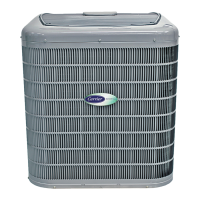

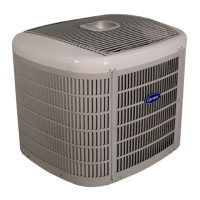


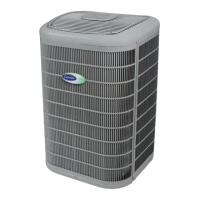

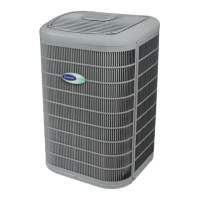
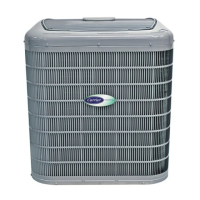
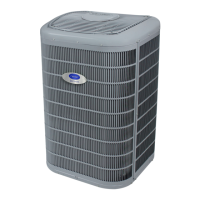

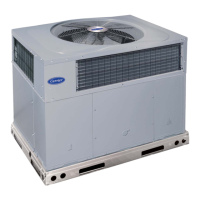
